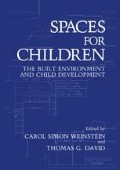Abstract
Once upon a time, even before Head Start was invented, we set out to look at the kinds of day care used by working mothers. Since virtually nothing was known about child-care arrangements at the time—except that there was not enough of it and that more was needed—we began by looking at a wide variety of centers. Their names gave some indication of their origins, sponsorship, and hopes for children. The old-time nurseries were often named for saints and were typically in old buildings, whereas the centers located on elementary-school sites usually bore unobtrusive street names. The privately owned centers sometimes had dignified names such as Miss Baines’ School (the word school was often featured prominently in the title). Others were more colorfully named: Fairyland; Cherubs’ Chalet; Kiddie Park; Kiddie College; even Kiddie Koop. Although we did not see it originally, eventually we came to identify some spatial patterns that fit certain categories of names.
Access this chapter
Tax calculation will be finalised at checkout
Purchases are for personal use only
Preview
Unable to display preview. Download preview PDF.
References
Barker, R. G. Ecological psychology. Stanford, CA: Stanford University Press, 1968.
Barker, R. G., & Wright, H. F. Midwest and its children. The psychological ecology of an American town. Evanston, IL: Row Peterson, 1954.
Bettelheim, B. A home for the heart. New York: Knopf, 1974.
Bruner, J. Under five in Britain. Ypsilanti, MI: High/Scope Educational Foundation, 1980.
Gump, P. The behavior of the same child in different milieus. In R. G. Barker (Ed.), The stream of behavior pp. 169–202. New York: Appleton-Century-Crofts, 1963.
Gump, P., & Sutton-Smith, B. Activity setting and social interaction. American Journal of Orthopsychiatry, 1955, 25, 755–760.
Hayward, G. D. An overview of psychological concepts of home. In R. L. Bauer (Ed.), Priorities for environmental design research (part 2). Washington, DC: Workshop Summaries, EDRA 8, 1978.
Kakar, S. Shamons, mystics and doctors: A psychological inquiry into India and its healing traditions. Boston: Beacon Press, 1982.
Kritchevsky, S., & Prescott, E. Physical space: Planning environments for young children. Washington, DC: National Association for the Education of Young Children, 1969.
Nicholson, S. How not to cheat children: The theory of loose parts. Landscape Architecture, 1970, 62 (1), 30–34.
Prescott, R. A pilot study of day care centers and their clientele. Washington, DC: U.S. Department of Health, Education, and Welfare, Children’s Bureau, 1965.
Prescott, E. A comparison of three types of day care and nursey school home care. Paper presented at the biennial meeting of the Society for Research in Child Development, Philadelphia, PA, 1973.
Prescott, E., & David, T. G. (1976). The effects of the physical environment on day care. Concept paper prepared for the U.S. Department of Health, Education, and Welfare, Office of Child Development, 1976.
Prescott, E., & Jones, E. Group day care as a child-rearing environment. Pasadena, CA: Pacific Oaks College, 1967.
Prescott, E., Jones, E., Kritchevsky, S., Milich, C., & Haselholf, E. Who thrives in group day care. Pasadena, CA: Pacific Oaks College, 1975.
Sherman, L. A. An ecological study of glee in small groups of preschool children. Child Development, 1973, 46, 53–61.
Waldrop, M. The necessity of intelligence. Science, 1984, 223, 1279–1282.
Weinstein, C. S. Modifying student behavior in the open classroom through changes in the physical design. American Educational Research Journal, 1977, 11, 249–162.
Author information
Authors and Affiliations
Editor information
Editors and Affiliations
Rights and permissions
Copyright information
© 1987 Plenum Press, New York
About this chapter
Cite this chapter
Prescott, E. (1987). The Environment as Organizer of Intent in Child-Care Settings. In: Weinstein, C.S., David, T.G. (eds) Spaces for Children. Springer, Boston, MA. https://doi.org/10.1007/978-1-4684-5227-3_4
Download citation
DOI: https://doi.org/10.1007/978-1-4684-5227-3_4
Publisher Name: Springer, Boston, MA
Print ISBN: 978-1-4684-5229-7
Online ISBN: 978-1-4684-5227-3
eBook Packages: Springer Book Archive

